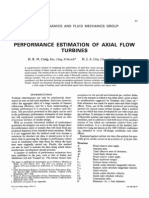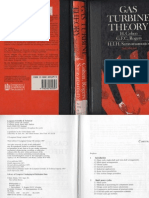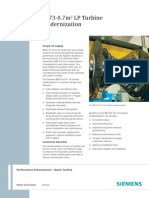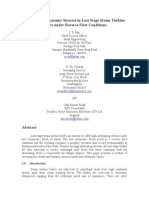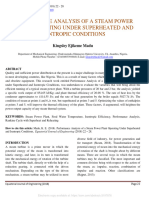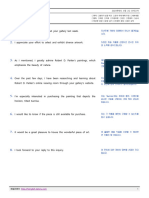Design and Thermal Analysis of Steam Turbine Blade Using Fem Method
Design and Thermal Analysis of Steam Turbine Blade Using Fem Method
Uploaded by
Md NisarCopyright:
Available Formats
Design and Thermal Analysis of Steam Turbine Blade Using Fem Method
Design and Thermal Analysis of Steam Turbine Blade Using Fem Method
Uploaded by
Md NisarOriginal Title
Copyright
Available Formats
Share this document
Did you find this document useful?
Is this content inappropriate?
Copyright:
Available Formats
Design and Thermal Analysis of Steam Turbine Blade Using Fem Method
Design and Thermal Analysis of Steam Turbine Blade Using Fem Method
Uploaded by
Md NisarCopyright:
Available Formats
AIJREAS VOLUME 3, ISSUE 5 (2018, MAY) (ISSN-2455-6300)ONLINE
Anveshana’s International Journal of Research in Engineering and Applied Sciences
DESIGN AND THERMAL ANALYSIS OF STEAM TURBINE BLADE
USING FEM METHOD
BURAGUMMALABVKISHORE NALLI ANIL KUMAR
Assistant Professor, Dept. of Mechanical M.Tech Student, , Dept. of Mechanical
Engineering, Akrg College of Engineering and Engineering, Akrg College of Engineering and
Technology, Nallajerla Technology, Nallajerla
Buragummalabvkishore@gmail.com Nanilambani@gmail.com
ABSTRACT assembly, which is a shaft or drum
with blades attached. Moving fluid acts on
A steam turbine is mechanical device which
converts thermal energy in steam into mechanical
the blades so that they move and impart
work. The steam turbine gives the better rotational energy to the rotor. Early turbine
thermodynamic efficiency by using multiple stages examples are windmills and waterwheels.
in the expansion of steam. The stages are
characterized by the way of energy extraction from Gas, steam, and water turbines have a
them is considered as impulse or reaction turbines. casing around the blades that contains and
In this thesis the parameters of steam turbine blade controls the working fluid. Credit for
varied and analysis is done for strength, life and invention of the steam turbine is given
heat transfer rates. The varied parameters are the
both to British engineer Sir Charles
ratio of X-axis distance of blade profile by chord
length and ratio of maximum height of blade profile Parsons (1854–1931) for invention of the
in Y-direction to the chord length. The 3D reaction turbine, and to Swedish
modelling is done by using catia software. The engineer Gustaf de Laval (1845–1913) for
ANSYS software is used for static, thermal analysis, invention of the impulse turbine. Modern
finally concluded the suitable design and material
steam turbines frequently employ both
(Haste alloy, Chrome steel, Inconel 600) for steam
turbine blade. reaction and impulse in the same unit,
typically varying the degree of
KEY WORDS: Steam Turbine, Thermal Energy, reaction and impulse from the blade root to
Impulse Turbine, Reaction Turbine, Static Analysis,
its periphery.
Thermal Analysis.
CHAPTER 1
TURBINE INTRODUCTION
1.1 INTRODUCTION
A turbine (from the Latin turbo, a vortex, FIG 1TURBINE
related to the Greek, meaning
"turbulence") is a rotary mechanical device 1.2 PRINCIPLE OF STEAM
that extracts energy from a fluid flow and TURBINE:
converts it into useful work. The work The steam energy is converted mechanical
produced by a turbine can be used for work. Expansion takes place through
generating electrical power when aby expansion through the turbine. series
combined with a generator or of fixed . In each row fixed blades
producing thrust, as in the case of jet (nozzles) and moving blades Blade and
engines. A turbine is a turbo machine with moving blade are called stage
at least one moving part called a rotor
Anveshana’s International Journal of Research in Engineering and Applied Sciences
EMAILID:anveshanaindia@gmail.com,WEBSITE:www.anveshanaindia.com
183
AIJREAS VOLUME 3, ISSUE 5 (2018, MAY) (ISSN-2455-6300)ONLINE
Anveshana’s International Journal of Research in Engineering and Applied Sciences
1. 2.1 Impulse steam turbine
The steam turbine is a device for obtaining
mechanical work from the energy stored in
steam. There are two main types of
turbine, the 'impulse' and the 'reaction'.
The names refer to the type of force which
acts on the blades to turn the turbine FIG 3 IMPLUSE BLADING
wheel. The impulse arrangement is made
up of a ring of nozzles followed by a ring 1.2.2 Reaction steam turbine
of blades. The high-pressure, high-energy
steam is expanded in the nozzle to a lower- The reaction arrangement is made up of a
pressure, high-velocity jet of steam. This ring of fixed blades attached to the casing,
jet of steam is directed into the impulse and a row of similar blades mounted on the
blades and leaves in a different direction . rotor, i.e. moving blades . The blades are
The changing direction and therefore mounted and shaped to produce a
velocity produces an impulsive force narrowing passage which, like a nozzle,
which mainly acts in the direction of increases the steam velocity. There is also
rotation of the turbine blades. There is only a change in velocity of the steam as a
a very small end thrust on the turbine result of a change in direction and an
shaft. impulsive force is also produced with this
type of blading. The more correct term for
this blade arrangement is 'impulse-
reaction'. A reaction turbine utilizes a jet
of Reaction steam turbine: steam that
flows from a nozzle on the rotor
FIG 2 IMPULSE STEAM TURBINE
The turbine consists of a single rotor he
single stage impulse turbine to which
impulse blades are attached .The steam is
fed through one or several convergent
nozzles. If high velocity of steam is
allowed to flow through one row of
moving bladesIt produces a rotor speed of. FIG 4 REATION TURBINE BLADE
about 30000 rpm which is too high for
practical use
CHAPTER 2
LITERATURE REVIEW
Many investigators have suggested various
methods to explain the effect of stress and
loading on turbine blade, roter and analysis
the various parameters: John. V, T.
Ramakrishna was investigated on design
and analysis of Gas turbine blade, CATIA
Anveshana’s International Journal of Research in Engineering and Applied Sciences
EMAILID:anveshanaindia@gmail.com,WEBSITE:www.anveshanaindia.com
183
AIJREAS VOLUME 3, ISSUE 5 (2018, MAY) (ISSN-2455-6300)ONLINE
Anveshana’s International Journal of Research in Engineering and Applied Sciences
is used for design of solid model and cycle costs, efficiency, and improve
ANSYS software for analysis for F.E. reliability Sanjay Kumar was investgated
model generated, by applying boundary on creep life of turbine blade. Inertia load
condition, this paper also includes specific is the constant load that will cause creep
post processing and life assessment of failure. Creep is a rate dependent material
blade. How the program makes effective nonlinearity in which material continues to
use of the ANSYS pre-processor to mesh deform in nonlinear fashion even under
complex geometries of turbine blade and constant load. This phenomenon is
apply boundary conditions. The principal predominant in components, which
aim of this paper is to get the natural exposed to high temperatures. By studying
frequencies and mode shape of the turbine the creep phenomenon and predicting the
blade. In this paper we have analyzed creep life of the component, we can
previous designs and generals of turbine estimate its design life. The main objective
blade to do further optimization, Finite is to predict the creep life of the simple
element results for free standing blades impulse steam turbine blade, and to give
give a complete picture of structural the FEM approach for creep analysis. The
characteristics, which can utilized for the analysis of turbine blade for different
improvement in the design and loads, which shows that the maximum
optimization of the operating conditions. stresses, induced in each case. These
stresses are within yield limit of the
Subramanyam Pavuluri, Dr. A. Siva material and will not undergo plastic
Kumar was investigated on design of high deformation during operationresult is
pressure steam turbine blade addresses the found that, creep life decreases as the
issue of steam turbine efficiency. A stress value increases. Hence, by
specific focus on airfoil profile for high- decreasing the stress value in the
pressure turbine blade, and it evaluates the component we can increase its creep life.
effectiveness of certain Chromium and This was be achieved by modifying the
Nickel in resisting creep and fracture in blade design. Avinash V. Sarlashkar,
turbine blades. The efficiency of the steam MARK L. Redding investigated on the
turbine is a key factor in both the architecture and capabilities of Blade Pro.
environmental and economic impact of An ANSYS based turbine blade analysis
any coal-fired power station. Based on the system with extensive automation for solid
research presented modifications to high- model and F.E. model generation,
pressure steam turbine blades can made to boundary condition application, file
increase turbine efficiency of the turbine. handling and job submission tasks for a
The results and conclusions are presented variety of complex analyses; the program
for a concerning the durability problems also includes turbo machinery specific post
experienced with steam turbine blades. processing and life assessment modules.
The maximum operational Von Mises Blade Pro is a cutting-edge example for
Stresses are within the yield strength of the vertical applications built on the core
material but the deformation is ANSYS engine using ANSYS APDL.
comparatively better for material CA-6 Examples of how the program makes
NM (Chromium Nickel). Modified effective use of the ANSYS preprocessor
solutions for Steam turbine blade values to to mesh complex geometries of turbine
machines to maximize their reduce life blade and apply boundary conditions are
Anveshana’s International Journal of Research in Engineering and Applied Sciences
EMAILID:anveshanaindia@gmail.com,WEBSITE:www.anveshanaindia.com
184
AIJREAS VOLUME 3, ISSUE 5 (2018, MAY) (ISSN-2455-6300)ONLINE
Anveshana’s International Journal of Research in Engineering and Applied Sciences
presented using specific examples. A real modification to the butting area and
world application is used to demonstrate reducing the fillet radius. To conduct the
the pre-processing capabilities, static and sensitivity analysis for the fillet stresses in
dynamic stress analyses results, generation blade and disk using FEA.
of Campbell and Interference diagrams
and life assessment. The principal
CHAPTER 3
advantage of Blade Pro is its ability to
PROJECT OVER VIEW
generate accurate results in a short amount
of time, thus reducing the design cycle 3. 1 STEAM TURBINE
time. The good correlation achieved is a NOMENCLATURE:
testament to the accuracy of the ANSYS
solvers and validity of the modeling
techniques adopted in Blade Pro.
DR.SHANTHARAJA.M, DR. Kumar. K.,
was work on the large variety of turbo-
machinery blade root geometries used in
industry prompted the question if an
optimum geometry could be found. An FIG 5 STEAM TURBINE BLADE
optimum blade root was defined, as a root NOMENCLATURE
with practical geometry which, when
loaded returns the minimum fillet stress 3.2 PROBLEM DEFINITION:
concentration factor. The present paper All modern steam power plants use
outlines the design modification for fillet impulse-reaction turbines as their blading
stresses and a special attention made on efficiency is higher than that of impulse
SCF of the blade root (T-root) which fails turbines. Last stage of steam turbine
and to guarantee for safe and reliable impulse-reaction blade are very much
operation under all possible service directly affect efficiency of plant with the
conditions. Finite Element Analysis is information that an understanding of the
used to determine the fillet stresses and forces and stresses acting on the turbine
Peterson’s Stress Concentration Factor blades is vital importance, in this work we
chart is effectively utilized to modify the will compute such a force acting on a last
blade root. The root modified due to the stage Low Pressure (LP) blade of a large
difficulty in manufacturing the butting steam turbine rotating at 3000 rpm in order
surface of the tang that grips the blade to to estimate the material stresses at the
the disk crowns A Review on Analysis of blade root. One such LP steam turbine
Low Pressure Stage of Steam Turbine blade is show in Figure 1. We studied
Blade with FEA (ANSYS Software) structural and themal analysis of blade
(IJSRD/Vol. 1/Issue 10/2013/0003) All using FEA for this work and by use of the
rights reserved by www.ijsrd.com 2060 operational data have performed by using
having small contact area. Verify the same FEA (ANSYS) and This study work
using Finite Element Analysis for two involved the analyze blade and check FEA
cases with and without the tang in the data of std. blade with various material.
blade. Firstly, to study the fillet stresses
with tang and then Petersons chart is used
to reduce the peak stresses with the
Anveshana’s International Journal of Research in Engineering and Applied Sciences
EMAILID:anveshanaindia@gmail.com,WEBSITE:www.anveshanaindia.com
185
AIJREAS VOLUME 3, ISSUE 5 (2018, MAY) (ISSN-2455-6300)ONLINE
Anveshana’s International Journal of Research in Engineering and Applied Sciences
3.3 OBJECTIVE Vm=velocity of steam in m/s
The objective of this project is to make a
Steam turbine blade different 3D model of M=1000kg/hr
the steam turbine blade, To study the static Vm=1310m/s
- thermal behaviour of the steam turbine
blade with different materials by F=362.87N
performing the finite element analysis.3D
Blade area=23319.1mm2
modelling software (catia v5) was used for
designing and analysis software (ANSYS) Pressure =F/A
was used for analysis.
P=0.01556N/mm2
3.4 METHODOLOGY
THE METHODOLOGY FOLLOWED 3.7 MATERIAL PROPERTIES
IN THE PROJECT IS AS FOLLOWS: TAB 1HASTELLOY PROPERTIES
Create a 3D model of the different
Steam turbine blades using
parametric software catia v5.
Convert the surface model into IGS
and import the model into ANSYS
to do analysis.
Perform static and thermal
analysis on the steam turbine blade.
Finally it was concluded which
material is the suitable for steam
turbine blade on these three TAB 2 INCONEL600 PROPERTIES
materials.
3.5 SCOPE OF THE PROJECT :
The scopes of this proposed project are:
1. To generate 3-dimensional geometry
model in catia workbench of the steam
turbine blade
2. To perform structural analysis on the
model to determine the stress, shear stress,
deformation, of the component under the
static- thermal load conditions
3. To compare analysis between three
different materials of steam turbine blade
3.6 LOAD CALCULATION:
𝐹 = 𝑀 × 𝑉𝑚
M=Mass of stream flowing through
turbine
Anveshana’s International Journal of Research in Engineering and Applied Sciences
EMAILID:anveshanaindia@gmail.com,WEBSITE:www.anveshanaindia.com
186
AIJREAS VOLUME 3, ISSUE 5 (2018, MAY) (ISSN-2455-6300)ONLINE
Anveshana’s International Journal of Research in Engineering and Applied Sciences
TAB 3 CHROME STEEL FIG 3 STEAM TURBINE BLADE IN
PROPERTIES CATIA WORK BENCH
NTRODUCTION TO
CHAPTER 5
5.1 ANALYSIS PROCEDURE IN
ANSYS:
Designed component in Catia workbench
after imported into Ansys workbench now
select the steady state thermal analysis.
1. ENGINEEERING MATERIALS
(MATERIAL PROPERTIES).
CHAPTER 4
2. CREATE OR IMPORT
4.1 DIMENSIONS AND DESIGN GEOMENTRY.
PROCEDURE IN CATIA:
Go to the sketcher workbench create 3. MODEL (APPLY MESHING).
profile blade shape by using spine and arcs
4. SET UP(BOUNDARY CONDITIONS)
as below dimensions after go to the part
design workbench apply pad as shown 5. SOLUTION
below figure
6. RESULTS
5.2 STATIC STRUCTURAL
ANALYSIS
The static structural analysis calculates the
stresses, displacements, strains, and forces
in structures caused by a load that does not
induce significant inertia and damping
effects. Steady loading and response
conditions are assumed; that the loads and
the structure’s response are assumed to
change slowly with respect to time. A
FIG 2BLADE DIMENSIONS static structural load can be performed
using the ANSYS WORKBENCH solver.
The types of loading that can be applied in
a static analysis include:
5.3 STEADY STATE THERMAL
ANALYSIS:
A steady state thermal analysis calculates
the effect of steady thermal load on a
system or component, analyst were also
doing the steady state analysis before
performing the transient analysis. A steady
Anveshana’s International Journal of Research in Engineering and Applied Sciences
EMAILID:anveshanaindia@gmail.com,WEBSITE:www.anveshanaindia.com
187
AIJREAS VOLUME 3, ISSUE 5 (2018, MAY) (ISSN-2455-6300)ONLINE
Anveshana’s International Journal of Research in Engineering and Applied Sciences
state analysis can be the last step of
transient thermal analysis. We can use
steady state thermal analysis to determine FIG 6 BOUNDARY CONDITION IN
temperature, thermal gradient, heat flow STEADY STATE THERMAL
rates and heat flux in an object that do not ANALYSIS
vary with time
CHAPTER 6
RESULTS AND DISCUSSION
6.1 STATIC ANALYSIS:
This analysis is performed to find
Structural parameters such as
Stresses,shearstress, Deformation, Here we
observed results on three materials namely
Fig 4Meshing Nodes 1580,elements 752 chrome steel, hastelloy, and Inconel as
shown below figures
5.4 BOUNDARY CONDITION
In static analysis fixed the bottom side 6.1.2 Chrome steel
after apply pressure on blade face
FIG 7 STRESS ON CHROME STEEL
FIG 5 BOUNDARY CONDITION IN
STATIC ANALYSIS
Boundary condition in steady state thermal
analysis: apply temperature 2290c, apply FIG 15 SHEAR STRESS ON CHROME
convection 220cfilm coefficient is STEEL
o
0.0025w/mm2 c
Anveshana’s International Journal of Research in Engineering and Applied Sciences
EMAILID:anveshanaindia@gmail.com,WEBSITE:www.anveshanaindia.com
188
AIJREAS VOLUME 3, ISSUE 5 (2018, MAY) (ISSN-2455-6300)ONLINE
Anveshana’s International Journal of Research in Engineering and Applied Sciences
FIG 20 STRESSES ON HASTELLOY
FIG 16 DEFORMATION ON
CHROME STEEL
6.1.3 Inconel material
FIG 21 SHEAR STRESS ON
HASTELLOY
FIG 17 STRESSES ON INCONEL
FIG 22 DEFORMATIONS ON
HASTEALLOY
CHAPTER 7. THERMAL ANALYSIS:
This analysis is performed to find thermal
parameters such as Here we observed
results on four materials chrome steel,
hastelloy, and Inconel as shown below
FIG 18 SHEAR STRESS ON figures
INCONEL
7.1 CHROME STEEL
FIG 19 DEFORMATION NIMONIC
80A
FIG 23 TEMPERATURE
6.1.4 HASTELLOY: DISTRIBUTION CHROME STEEL
Anveshana’s International Journal of Research in Engineering and Applied Sciences
EMAILID:anveshanaindia@gmail.com,WEBSITE:www.anveshanaindia.com
189
AIJREAS VOLUME 3, ISSUE 5 (2018, MAY) (ISSN-2455-6300)ONLINE
Anveshana’s International Journal of Research in Engineering and Applied Sciences
FIG 28 HEAT FLUX ON INCONEL
600
7.3 GRAPH
7.3.1 Stress graph
This graph shows the different
maximum stress values in different
FIG 24 HEAT FLUX CHROME materials, chrome steel, hastelloy, and
STEEL Inconel materials, hastelloy has least
shear stress value of 8.49Mpa
7.2 HASTELLOY:
compared to another materials as
shown in the graph 1
FIG 25 TEMPERATURE
DISTRIBUTIONS ON HASTELLOY
FIG 29 STRESS GRAPH
7.3.2 Total deformation graph
This graph shows the different total
deformation values in different
FIG 26 HEAT FLUX ON HASTELLOY materials, chrome steel, hastelloy, and
INCONEL 600: Inconel, hastelloy material has least
total deformation value of 0.0026mm
compared to another materials as
shown in the graph 1
FIG 27 TEMPERATURE
DISTRIBUTION ON INCONEL 600
FIG 30 TOTAL DEFORMATION
GRAPH
Anveshana’s International Journal of Research in Engineering and Applied Sciences
EMAILID:anveshanaindia@gmail.com,WEBSITE:www.anveshanaindia.com
190
AIJREAS VOLUME 3, ISSUE 5 (2018, MAY) (ISSN-2455-6300)ONLINE
Anveshana’s International Journal of Research in Engineering and Applied Sciences
7.3.3 Shear stress graph of 0.772w/mm2 compared to another
materials as shown in the graph 1
This graph shows the different total
deformation values in different
materials, chrome steel, hastelloy, and
Inconel , inconel material has least
shear stress compared to another
materials 0.53mpa as shown in the
graph 1
FIG 33 HEAT FLUX GRAPH
CHAPTER 8
CONCLUSION
Modeling of steam turbine blade is done
FIG 31 SHEAR STRESS GRAPH
by using CATIAV5 Software and then the
7.3.4 Temperature distribution graph model is imported into ANSYS Software
for Structural analysis on the steam turbine
This graph shows the different blade to check the quality of materials
temperature distribution values in such as, chrome steel, hastelloy, and
different materials, chrome steel, Inconel. From the obtained Von-misses
hastelloy, and Inconel , hastelloy has stresses, shear stress , deformation,
highest temp distribution value of temperature distribution and heat flux for
13.403 (0c)(min) compared to another the materials, respectively Compared with
materials as shown in the graph 2 all materials hastelloy material have less
stresses, deformations, and High
temperature distribution and heat flux
values .Finally from structural analysis and
thermal analysis based on results it is
concluded that haste alloy material is
suitable material for stream turbine .
FIG 32 TEMPERATURE REFERENCES
[1]Reliability design method for turbine blades by
DISTRIBUTION GRAPH Jinyuan Shi.
7.3.5 Heat flux graph [2]Design and analysis of steam turbine blades
using FEM by K. Matta , R.B.Pothula, R.U. Rao
This graph shows the different heat
flux values in different materials, [3]Experimental investigation on design of high
pressure steam turbine blade by Subramanyam
chrome steel, hastelloy, and Inconel,
Pavuluri , Dr. A. Siva kumar
hastelloy has highest heat flux value
Anveshana’s International Journal of Research in Engineering and Applied Sciences
EMAILID:anveshanaindia@gmail.com,WEBSITE:www.anveshanaindia.com
191
AIJREAS VOLUME 3, ISSUE 5 (2018, MAY) (ISSN-2455-6300)ONLINE
Anveshana’s International Journal of Research in Engineering and Applied Sciences
[4]Design modification for fillet stresses in steam
turbine blade by Tulsidas d, Dr. Shantharaja. M,
Dr.Kumar.K
[5]Analysis of steam turbines by A. Sudheer Reddy,
MD. Imran Ahmed, T.Sharath Kumar, A.Vamshi
Krishna Reddy, V. V. Prathibha Bharathi.
[6]Design optimization and static & thermal
analysis of gas turbine blade by Ganta Nagaraju,
Venkata Ramesh Mamilla, and M.V.Mallikarjun.
[7]A Review on analysis of low pressure stage of
steam turbine blade with FEA by kinnarrajsinh
P.Zala, Dr.K.M.Srivastava, Nilesh.H. Pancholi.
Anveshana’s International Journal of Research in Engineering and Applied Sciences
EMAILID:anveshanaindia@gmail.com,WEBSITE:www.anveshanaindia.com
192
You might also like
- Introduction To TurbomachineryDocument1 pageIntroduction To TurbomachineryRAJENDRA PADAMATA0% (2)
- Performance Estimation of Axial Flow TurbinesDocument34 pagesPerformance Estimation of Axial Flow TurbinesRamraj Harikanth100% (2)
- Epri Turbine A Vapeur PDFDocument53 pagesEpri Turbine A Vapeur PDFamarmissoum100% (3)
- (Không kể thời gian phát đề) (Đề thi có 07 trang)Document7 pages(Không kể thời gian phát đề) (Đề thi có 07 trang)Nguyễn MoonNo ratings yet
- Design and Structural Thermal Analysis of Gas Turbine Rotor Blade With Radial Holes Using SolidworksDocument5 pagesDesign and Structural Thermal Analysis of Gas Turbine Rotor Blade With Radial Holes Using SolidworksEditor IJTSRDNo ratings yet
- Modeling and Analysis of Steam Turbine Blade-Ijaerdv05i0451562n PDFDocument11 pagesModeling and Analysis of Steam Turbine Blade-Ijaerdv05i0451562n PDFGuruvenu KamanuruNo ratings yet
- Elliott Brush Ring Seals: Installation KitDocument2 pagesElliott Brush Ring Seals: Installation Kitfouzi gher100% (1)
- OM0401 Overview of Turbine Version GDocument41 pagesOM0401 Overview of Turbine Version Gمحمد خالد100% (1)
- Cohen - Gas Turbine TheoryDocument42 pagesCohen - Gas Turbine TheoryJenny PerezNo ratings yet
- BB73-8.7m2 LP TurbineDocument2 pagesBB73-8.7m2 LP TurbineMan HumanNo ratings yet
- Off-Design Flow Analysis and Performance Prediction of Axial TurbinesDocument13 pagesOff-Design Flow Analysis and Performance Prediction of Axial TurbinesaliNo ratings yet
- Thermal Energy Steam Sir Charles ParsonsDocument18 pagesThermal Energy Steam Sir Charles ParsonsgauravNo ratings yet
- Design and Analysis of Steam Turbine BladesDocument7 pagesDesign and Analysis of Steam Turbine BladesaliNo ratings yet
- PHD Dissertation 1999 Kessler PDFDocument111 pagesPHD Dissertation 1999 Kessler PDFDeepak AshokanNo ratings yet
- APD Dynamic StressesDocument11 pagesAPD Dynamic StressesadehriyaNo ratings yet
- Forces On Large Steam Turbine Blades: RWE NpowerDocument5 pagesForces On Large Steam Turbine Blades: RWE NpoweradawNo ratings yet
- Unsteady Flow Visualisation T Akes The Heat Out of Hot SpotsDocument2 pagesUnsteady Flow Visualisation T Akes The Heat Out of Hot SpotsDeepak Chachra100% (1)
- Fact Sheet Til 1292Document2 pagesFact Sheet Til 1292PervimNo ratings yet
- The Design and Analysis of Gas Turbine BladeDocument3 pagesThe Design and Analysis of Gas Turbine Bladeaerobrother100% (4)
- Paper-Creep Life Estimation of T22Document9 pagesPaper-Creep Life Estimation of T22Parmanand RautNo ratings yet
- M PM 170Document34 pagesM PM 170mahesh_eilNo ratings yet
- DETC2009-86080: The Use of Interference Diagrams To Avoid Impeller Resonance: An Application To Igv DesignDocument8 pagesDETC2009-86080: The Use of Interference Diagrams To Avoid Impeller Resonance: An Application To Igv DesignRajesh KachrooNo ratings yet
- API Standard 612 - Special Purpose Steam Turbines For Petroleum, Chemical, and Gas Industry ServicesDocument1 pageAPI Standard 612 - Special Purpose Steam Turbines For Petroleum, Chemical, and Gas Industry ServicesHamed HamedNo ratings yet
- Turbo PumpDocument84 pagesTurbo PumpNecdet DemiralpNo ratings yet
- Tribology Activities at DMRL: Defence Metallurgical Research Laboratory Hyderabad-500058, IndiaDocument17 pagesTribology Activities at DMRL: Defence Metallurgical Research Laboratory Hyderabad-500058, IndiaSwati Lalit ThakurNo ratings yet
- Mil HDBK 506Document15 pagesMil HDBK 506Jais JohnNo ratings yet
- ME8792 PPE by WWW - Learnengineering.inDocument136 pagesME8792 PPE by WWW - Learnengineering.inKarthi BENo ratings yet
- Gas Turbine - PDFDocument214 pagesGas Turbine - PDFSreepriodas RoyNo ratings yet
- MacCormack MethodDocument1 pageMacCormack MethodAbhishek AjansondkarNo ratings yet
- Averaging Nonuniform Flow For A PurposeDocument10 pagesAveraging Nonuniform Flow For A PurposeAli Al-hamalyNo ratings yet
- Design and Analysis of Gas Turbine Rotor Blade Using Finite Element MethodDocument22 pagesDesign and Analysis of Gas Turbine Rotor Blade Using Finite Element MethodTJPRC PublicationsNo ratings yet
- Transporte de Los Generadores de Gas Rb211 y Avon Rolls Royce 3Document12 pagesTransporte de Los Generadores de Gas Rb211 y Avon Rolls Royce 3Denis JimenezNo ratings yet
- Hangzhou Steam Turbine Back PressureDocument1 pageHangzhou Steam Turbine Back PressureNavin KumarNo ratings yet
- Condition Monitoring Ensures Against Mechanical Failure 020912Document8 pagesCondition Monitoring Ensures Against Mechanical Failure 020912satya krishna chagantiNo ratings yet
- Nuclear Power Plant Steam Turbine-Modeling For Model Based Control PurposesDocument25 pagesNuclear Power Plant Steam Turbine-Modeling For Model Based Control PurposesMuhammad Junaid DarNo ratings yet
- Lifetime Extension Steam TurbineDocument10 pagesLifetime Extension Steam Turbineramakantinamdar100% (1)
- AE6812 Prop Lab ManualDocument45 pagesAE6812 Prop Lab ManualAeronautical Engineering HODNo ratings yet
- Engineering Technology DivisionDocument20 pagesEngineering Technology DivisionseeaNo ratings yet
- Curtis TurbineDocument18 pagesCurtis TurbineDivya Prakash SrivastavaNo ratings yet
- ML010310397Document227 pagesML010310397raniawork2006No ratings yet
- ROTALIGN-Ultra Shaft-Alignment ALI9-846 02-05 1.20 G PDFDocument88 pagesROTALIGN-Ultra Shaft-Alignment ALI9-846 02-05 1.20 G PDFDon FreemanNo ratings yet
- Design and Calculation Ofsteam-Turbine D Isk W Heels: NtroductionDocument16 pagesDesign and Calculation Ofsteam-Turbine D Isk W Heels: NtroductionKonderu Anil100% (1)
- Solid Particle Erosion and Mechanical DamageDocument5 pagesSolid Particle Erosion and Mechanical DamageCarlos ToscanoNo ratings yet
- Introduction To Turbomachinery Final Exam 1SY 2016-2017Document1 pageIntroduction To Turbomachinery Final Exam 1SY 2016-2017Paul Rodgers100% (1)
- Power Plant Part2Document80 pagesPower Plant Part2مصطفى العبادي100% (2)
- Design and Analysis of Gas TurbineDocument6 pagesDesign and Analysis of Gas Turbineiamdopev2.0No ratings yet
- Steam Turbine-Part III - Trip and Throttle ValveDocument7 pagesSteam Turbine-Part III - Trip and Throttle ValveAahmer Hasan100% (1)
- Axial CompressorsDocument24 pagesAxial CompressorsVamsi MahantiNo ratings yet
- Report-Crack Depth-Gas Turbine DiscDocument6 pagesReport-Crack Depth-Gas Turbine DiscOm Ar TanNo ratings yet
- Steam Turbine and Governor (SimPowerSystems)Document5 pagesSteam Turbine and Governor (SimPowerSystems)hitmancuteadNo ratings yet
- Exp4 1310020 (RS) PDFDocument15 pagesExp4 1310020 (RS) PDFFazlul HaqueNo ratings yet
- Throttling ProcessDocument3 pagesThrottling ProcessFarhatul Abrar AnandaNo ratings yet
- Steam Turbine Study Emg 32/25: Title: Document Code RevisionDocument23 pagesSteam Turbine Study Emg 32/25: Title: Document Code RevisionUdhayakumar Venkataraman100% (1)
- Chap 6 Reaction TurbineDocument10 pagesChap 6 Reaction TurbineSourabh SalunkheNo ratings yet
- An Optimum Set of Loss Models For Performance Prediction of Centrifugal CompressorsDocument9 pagesAn Optimum Set of Loss Models For Performance Prediction of Centrifugal CompressorsEllen KindermannNo ratings yet
- A Research Paper On Design and Analysis of Shaftless Steam TurbineDocument5 pagesA Research Paper On Design and Analysis of Shaftless Steam TurbineEditor IJTSRDNo ratings yet
- The Types of Mechanical and Thermal Stresses On The First Stage Rotor Blade of A TurbineDocument11 pagesThe Types of Mechanical and Thermal Stresses On The First Stage Rotor Blade of A TurbineNIDIA SULAY HERNANDEZ CASTELLARNo ratings yet
- SSRN Id3197876Document7 pagesSSRN Id3197876Muhammad IlhamNo ratings yet
- Static and Thermal Analysis of Gas Turbine Rotor BladeDocument15 pagesStatic and Thermal Analysis of Gas Turbine Rotor BladeJUKANTI VISHWASNo ratings yet
- Turbine - WikipediaDocument6 pagesTurbine - Wikipediarpraj3135No ratings yet
- Amazing Animal Families: Warm UpDocument1 pageAmazing Animal Families: Warm UpMILDRED MANALILINo ratings yet
- Cloud Computing Notes 1Document12 pagesCloud Computing Notes 1Roshan JhaNo ratings yet
- Lesson 15 - OB GYN, Neurology, Surgery BackupDocument28 pagesLesson 15 - OB GYN, Neurology, Surgery BackupAlejandro GuerreroNo ratings yet
- Lecture 3 Bilinear TFDocument32 pagesLecture 3 Bilinear TFNathan KingoriNo ratings yet
- (23 3 2)Document28 pages(23 3 2)idyejun901No ratings yet
- BT Hoa Mat TroiDocument133 pagesBT Hoa Mat Troingoc lanNo ratings yet
- Model Driven Soft - EngineeringDocument184 pagesModel Driven Soft - EngineeringCreative DesignerNo ratings yet
- Cochise Regional Hospital Pharmacy Services POLICY and PROCEDURE MANUAL (PDFDrive)Document212 pagesCochise Regional Hospital Pharmacy Services POLICY and PROCEDURE MANUAL (PDFDrive)hosp.phaNo ratings yet
- Sona Koyo FinalDocument14 pagesSona Koyo Finalkritikam88No ratings yet
- UrbanQuest Boston CommonDocument15 pagesUrbanQuest Boston CommonmandabandaNo ratings yet
- Access at This Point - With Perhaps 15-20 Percent of Research Articles Made FreelyDocument23 pagesAccess at This Point - With Perhaps 15-20 Percent of Research Articles Made FreelyIchlasulNo ratings yet
- IGNOU MCSP232 Project GuidelinesDocument20 pagesIGNOU MCSP232 Project GuidelinesAnmol ThakurNo ratings yet
- CompTIA Cybersecurity Career PathwayDocument2 pagesCompTIA Cybersecurity Career PathwayFirdamdam SasmitaNo ratings yet
- 2N3637Document0 pages2N3637Deepa DevarajNo ratings yet
- Ground Floor Plan: Area CalculationDocument1 pageGround Floor Plan: Area CalculationShrutikhare10799 PasswordfortabNo ratings yet
- A Study On Productivity and Competitiveness of IndianDocument17 pagesA Study On Productivity and Competitiveness of Indianroyal achieverNo ratings yet
- Wrongful Foreclosure SurveyDocument2 pagesWrongful Foreclosure SurveyForeclosure FraudNo ratings yet
- Glass IndustryDocument8 pagesGlass IndustryKarthik ArumughamNo ratings yet
- EARTH SCIENCE-WPS OfficeDocument10 pagesEARTH SCIENCE-WPS OfficeJasmin AquinoNo ratings yet
- Defining Performance DimensionsDocument4 pagesDefining Performance DimensionsJaneNo ratings yet
- Hubungan Karakteristik Morfofisiologi Tanaman Kersen (Muntingia Calabura)Document6 pagesHubungan Karakteristik Morfofisiologi Tanaman Kersen (Muntingia Calabura)Spring BlossomNo ratings yet
- A Study On Second Language Learners PDFDocument8 pagesA Study On Second Language Learners PDFAzura W. ZakiNo ratings yet
- Sankaran View of MiasmsDocument122 pagesSankaran View of Miasmsaparesh kumar banerjee0% (1)
- Basic Film History: Homework AssignmentDocument10 pagesBasic Film History: Homework AssignmentBijayNo ratings yet
- S-14 - Roof Framing PlanDocument1 pageS-14 - Roof Framing PlanJames PittsNo ratings yet
- Surface Phenomena PDFDocument5 pagesSurface Phenomena PDFDurga Prasad KalamNo ratings yet
- Discovery School Super League Season 3Document2 pagesDiscovery School Super League Season 3Anita Agarwal100% (2)
- Moduflex Brochure Uk 2014Document12 pagesModuflex Brochure Uk 2014FernandoNo ratings yet
- Unit Twenty: Index: This Tennis A Latin Word That Means He Who or That.w, HichDocument29 pagesUnit Twenty: Index: This Tennis A Latin Word That Means He Who or That.w, HichHellenNdegwaNo ratings yet

